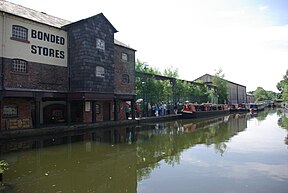Stourbridge Canal
| Stourbridge Canal | |
|---|---|

The terminus of the Stourbridge Town arm of the canal
|
|
| Specifications | |
| Locks | 20 |
| Status | Open |
| Navigation authority | Canal and River Trust |
| History | |
| Original owner | Stourbridge Canal Company |
| Principal engineer | Thomas Dadford |
| Date of act | 1776 |
| Date of first use | 1779 |
| Geography | |
| Start point | Brierley Hill |
| End point | Stourton, Staffordshire |
| Connects to | Staffs & Worcs Canal, Dudley Canal |
The Stourbridge Canal is a canal in the West Midlands of England. It links the Staffordshire and Worcestershire Canal (at Stourton Junction, affording access to traffic from the River Severn) with the Dudley Canal, and hence, via the Birmingham Canal Navigations, to Birmingham and the Black Country.
The Stourbridge and Dudley canals were originally proposed as a single canal in 1775, with a primary purpose of carrying coal from Dudley to Stourbridge. Robert Whitworth had carried out a survey, which was approved at a meeting held in Stourbridge in February, at which the estimated cost was promised by subscribers. The chief promoter was Lord Dudley, but the bill was withdrawn from Parliament following fierce opposition from the Birmingham Canals. Two bills were presented in the autumn, one for each of the canals, with the details largely unchanged, and both became Acts of Parliament on 2 April 1776, despite continued opposition from Birmingham. The Act allowed the promoters to raise £30,000, but unlike most such acts, did not make any provision for additional amounts. Thomas Dadford was appointed as engineer, with James Green as an assistant. Work started on the aqueduct which would carry the canal over the River Stour.
The £30,000 of share capital had been spent by April 1778, and although not authorised to do so, the company issued bonds to raise more money. Construction was largely complete by 1779, and trading began. All of the canal was probably open by December. Dadford resigned in 1781, and the following year, a second Act of Parliament was obtained, to authorise the raising of an extra £10,000, and to legitimise the bonds already issued. The total cost was thus £43,000. Tolls on coal which originated on the canal and was then carried on the Staffordshire and Worcestershire Canal were higher than for other coal on that canal, and the Stourbridge Company had failed to get this clause repealed. They therefore sought to bypass the Staffordshire and Worcestershire Canal, and approached the Birmingham Canals in 1784, with a proposal for a link between the Dudley Canal and their system. This resulted in an Act to build the Dudley Tunnel, which opened in 1792. They also proposed a 26-mile (42 km) canal from Stourbridge to the River Severn at Diglis, which would have required two tunnels and 128 locks. The bill was rejected in 1786 when it reached the House of Lords, following opposition by the Staffordshire and Worcestershire company, but they reduced their tolls for Stourbridge coal two years later. A healthy trade in coal, ironstone and limestone developed, supplemented by iron products, bricks, clay, earthenware and glass. A dividend of 2.45 per cent was paid in 1785, which had risen to 6.3 per cent by 1789.
...
Wikipedia
